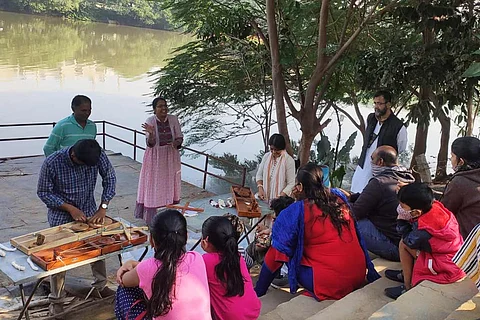

It was around June 2016 that Madhulika Choudary from Dhruvansh, an NGO that works for environment protection and lake restoration in Hyderabad, saw a dead body floating at the Neknampur lake and it wasn't the first time. This was apart from regular garbage dumped in the lake, consisting of mattresses, plastics, weeds, sewage and carcasses of animals and others.
Five years later, in 2021, the lake has transformed into a picturesque spot which also has various eco-friendly and cultural events on weekends. At these activities organised by Dhruvansh, people learn about sustainable ways of living, while enjoying the sight of ‘floating islands’ on the lake. These floating islands, started by Dhruvansh in 2018, are essentially phytoremediation plants that are sown on a base repurposed with bamboo matrix and styrofoam sheets, and encapsulated in tarpolene sheets. Phytoremediation is a process which uses plants to remove pollutants from the water, thus helping keep the lake clean.
In October 2020, Dhruvansh started a special campaign called Back to Roots, under which events like potter wheel, parampara series with Kuchipudi dance, conversion of regular bicycle to electric cycle workshops, awareness campaigns on recycling, reusing and waste management, and informative sessions on biodiversity have been organised. All the events take place at the ‘floating’ amphitheatre setup that gives a full view of the lake to visitors.

Most of these events are open to everyone for free or and workshops which provide materials, have separate costs. Many times, the events are popularised through word of mouth and through closed groups to avoid overcrowding.
One of the regular visitors, Pinki Agarwal, from Glendale Academy, says that she didn’t expect such a transformation of the lake with “fresh air and lovely view.” “I go to the lake with my students and they enjoy it very much. In the past I have attended awareness sessions and workshops on waste management, making cloth bags and many more.”

She further recalls that on the last Independence Day, at a waste management event, all the children were brought used and dried milk packets from their homes. “The children were shown how these packets can be used as grow bags for small plants instead of buying separate plastic bags. The children were all so impressed and they still collect milk packets at their home,” shares Pinki.
Sowmya, a 26-year-old software engineer who also lives near the lake, talks about how events like these create an atmosphere of peace and serenity. “The small things make a a lot of difference on how we perceive the lake as a space to feel peaceful.”


Impressed by the efforts going into maintaining the lake, visitors are inspired to get involved and volunteer. Sowmya, who started volunteering there during weekends, says, “Each and every session teaches me something new.”
Explaining what motivates to volunteer at the lake, Sowmya explains, “It's not like we revive one lake and move on to another. If we did that, the lake would go back to its old state. After the lake is revived, it's the community that understands its value and keeps it healthy. That's what is happening right now. Residents are coming to the lake, seeing the importance and problems that the lake is facing and are getting involved directly.”
Meanwhile Madhulika has bigger plans for the rejuvenated lake. “I want to covert this lake into an environment incubation centre so that people learn that the lake is not just a place to roam about, it's much more than that.” For instance, she adds, the lake has become a place of rich biodiversity, with about 225 bird species,15 varieties of reptiles and 300 varieties of insects. “The lake has many rare species as well. I have spotted rare species like Eurasian wryneck bird, the civet cat, monitor lizards, rock pythons, night jars,” she notes. The lake also has numerous plant species including several medicinal plants and mosquito repellant plants.

Madhulika believes that community participation is the key to keeping the lake clean and healthy and sustainability events are a step in the same direction.